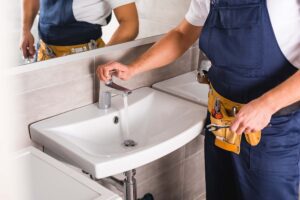Dishwashers are an integral part of modern kitchens, providing a convenient way to clean dishes without the effort of scrubbing and washing by hand. However, when your dishwasher’s plumbing starts leaking behind the walls, it can lead to serious damage that may go unnoticed for quite some time. Hidden leaks behind the walls can be difficult to detect and often cause extensive damage to the structure, flooring, and cabinetry in your kitchen. This comprehensive guide will help you understand how to identify the signs of a leak, the possible causes, and how to repair it.
Understanding Hidden Dishwasher Leaks
Dishwasher plumbing leaks behind walls can arise from several potential causes. These leaks often occur in the pipes, seals, or hoses that carry water to and from the dishwasher. Understanding these causes can help you prevent and address the problem effectively.
Here are some common causes of hidden dishwasher plumbing leaks:
Worn or Damaged Hoses
Over time, the hoses connected to your dishwasher can become brittle, cracked, or disconnected, leading to water leakage behind your walls. Hoses are typically made from rubber or plastic, materials that can deteriorate from prolonged exposure to hot water and high-pressure conditions.
Loose or Faulty Connections
The plumbing connections between your dishwasher and the water supply can become loose or misaligned, which can cause water to leak during the dishwasher’s operation. These leaks are particularly problematic because they often go unnoticed until the water seeps into the surrounding structures.
Cracked or Deteriorated Seals
Dishwashers rely on seals and gaskets to keep water contained during the wash cycle. If these seals become cracked or worn out, water can escape into the cabinet and potentially seep into the walls, causing damage over time.
Improper Installation
If your dishwasher was not installed correctly, it could lead to issues such as misaligned pipes, leaking hoses, or improperly sealed connections. In some cases, improper installation can cause leaks behind the wall, which are much harder to detect without professional assistance.
Signs of a Hidden Leak
Detecting a plumbing leak behind the walls early is crucial to preventing significant damage. However, because these leaks often remain hidden, they can cause silent damage that worsens over time. Here are some common signs that you may have a leak behind your dishwasher or within the plumbing system:
1. Damp or Discolored Drywall
If water has been leaking behind the wall for a prolonged period, it can lead to dampness or discoloration of the drywall near your dishwasher or sink area. You may notice that the wall feels soft or mushy, or the paint may begin to peel or bubble.
2. Soft or Swollen Baseboards
Water leaking from the plumbing behind the walls can also cause baseboards to swell or warp. Soft, swollen baseboards are a clear indication that there is moisture in the wall.
3. Musty or Moldy Odors
The presence of excess moisture in your walls creates an ideal environment for mold and mildew to grow. If you start noticing a musty or moldy smell near your dishwasher, it could be a sign that water has been leaking behind the walls for some time.
4. Visible Water Stains Near the Dishwasher
While this might seem obvious, it’s worth mentioning that water stains or puddles near the base of your dishwasher could indicate a leaking pipe or hose. If the water seems to be coming from the plumbing behind the wall, it’s time to investigate further.
Steps to Detect and Repair the Leak
If you suspect there is a plumbing leak behind your dishwasher, it’s important to act quickly. Here’s a step-by-step guide on how to detect and repair the issue:
1. Turn Off the Water Supply
Before inspecting or attempting any repairs, make sure to turn off the water supply to your dishwasher to prevent further leakage and potential water damage. You can usually turn off the water supply by locating the shut-off valve under the sink.
2. Inspect Visible Components
Check the hoses, connections, and door seals of your dishwasher. Look for cracks, wear, or loose connections. Even a small crack or hole in a hose can lead to a significant leak. If you find any faulty components, replace them immediately to prevent further leaks.
3. Conduct a Leak Test
If there are no visible signs of damage but you still suspect a leak, place a few paper towels around the base of your dishwasher. Run a short wash cycle and inspect the towels after the cycle finishes. If they are wet, it could indicate a leak at the base of the dishwasher.
4. Check for Water Behind the Wall
If the visible components appear intact, you may need to check behind the wall. Start by using a moisture meter, which can detect the presence of moisture inside the wall. If you do not have a moisture meter, you may need to remove a section of drywall to gain access to the plumbing behind the wall.
5. Repair the Leak
Once you’ve identified the source of the leak, you can proceed with repairing it. For a cracked hose, you may need to replace the hose entirely. For a loose or misaligned connection, simply tighten the connection or replace the gasket if necessary. If you’re not comfortable with these repairs, it’s best to consult a licensed plumber.
Common Causes of Dishwasher Plumbing Leaks
Here’s a detailed breakdown of the most common causes of plumbing leaks behind the walls:
| Cause | Description |
| Worn Door Seal | A damaged door seal can cause water to escape during the wash cycle, leading to leaks. Seals often wear out over time due to repeated use and exposure to heat and water. |
| Loose or Cracked Hoses | The water supply hoses or drain hoses can become loose or cracked, leading to water seeping into the surrounding structures behind the wall. |
| Improper Installation | Poorly installed plumbing connections, hoses, or pipes can lead to leaks that are difficult to detect. |
| Clogged Drain | A clogged drain can cause water to back up and overflow, leaking behind the wall and causing damage to your kitchen. |
Preventing Future Leaks
To minimize the risk of plumbing leaks in the future, follow these preventive tips:
- Regularly Inspect Hoses and Seals: Periodically check the hoses and seals on your dishwasher to ensure they are in good condition. Replace them if they show signs of wear or damage.
- Proper Installation: If you’re installing a new dishwasher, make sure it’s properly installed by a professional. Ensure that all plumbing connections are secure and correctly aligned.
- Use the Correct Detergent: Avoid using excess detergent, as this can lead to suds overflowing from the dishwasher and causing leaks. Always follow the manufacturer’s instructions for detergent usage.
- Schedule Regular Professional Inspections: It’s a good idea to have a plumber inspect your dishwasher and plumbing system at least once a year to detect any potential issues before they become serious problems.
Professional Detection Methods
If you’re unable to locate the leak on your own, professionals have advanced tools and techniques to detect hidden leaks. These methods include:
- Thermal Imaging Cameras: These cameras can detect temperature differences in the wall, indicating the presence of moisture behind the drywall.
- Acoustic Sensors: These devices pick up the sounds of water escaping from pipes and can help pinpoint the exact location of a leak.
- Moisture Meters: These meters measure the moisture levels in walls and floors, which can help locate the source of a hidden leak.
Hiring a professional plumber can save you time and prevent unnecessary damage by accurately identifying the leak’s location.
Conclusion
Dishwasher plumbing leaks behind the walls are a serious issue that can cause significant damage if not addressed quickly. Regular inspections and maintenance can help prevent leaks, but if you do encounter a problem, follow the steps above to detect and repair the issue. If you’re not comfortable making the repairs yourself, it’s always a good idea to consult a licensed plumber to ensure the leak is properly addressed. By taking proactive steps, you can protect your kitchen from water damage and extend the life of your dishwasher.
FAQs
What are the common causes of a dishwasher plumbing leak behind the wall?
Common causes include damaged hoses, loose or misaligned connections, deteriorated seals, and improper installation of the dishwasher or plumbing.
How can I tell if my dishwasher is leaking behind the walls?
Look for signs like damp or discolored drywall, swollen baseboards, musty smells, or visible water stains around the dishwasher area.
Can I fix a dishwasher plumbing leak behind the wall myself?
If you’re comfortable with basic plumbing, you can check visible components and conduct a leak test. However, if the leak is behind the wall, it’s best to consult a professional plumber for proper diagnosis and repair.
What should I do if I suspect a hidden leak behind my dishwasher?
Turn off the water supply, check visible components for damage, and consider using a moisture meter to detect hidden leaks. If needed, remove drywall to inspect the plumbing.
How can I prevent future leaks in my dishwasher plumbing?
Regularly inspect hoses, seals, and connections, ensure proper installation, avoid overuse of detergent, and schedule periodic plumbing inspections to catch issues early.



